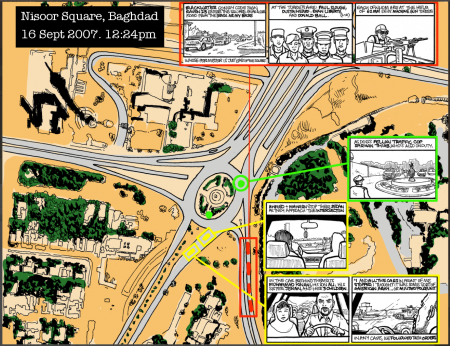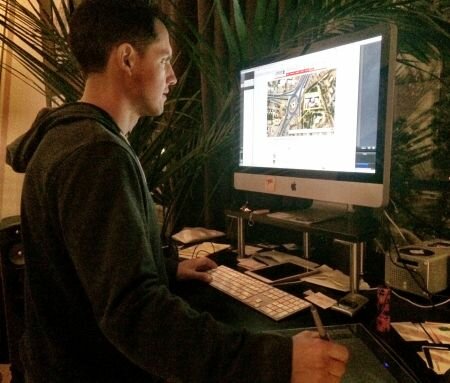The Nisoor Square Shootings
A piece of graphic journalism, which reconstructs the Blackwater Killings in 2007 on a central roundabout near Bagdad through an interactive webcomic imported into Google Maps.
What is it?
The Nisoor Square Shootings is an interactive webcomic by graphic journalist Dan Archer (@archcomix) chronicling a killing spree in Bagdad that involved US private security firm Blackwater. The event resulted in the death of 17 Iraqi civilians and left 24 wounded.

Afterwards, the American guards claimed they had started shooting in self-defense, but eyewitnesses and traffic police told a different story, alleging that they shot unarmed civilians without being in any danger.
The event raised concerns about the role of private contractors in war zones. U.S. security firms operating in Iraq were immune to prosecution under an order by the U.S. State Department issued after the 2003 Iraq invasion.
In 2010, reporting on this then still unresolved bloodbath, Archer employs digital tools of webcomics journalism to offer a complex, multi-layered view of the incident, based on existing news reports and eyewitness testimonies.

How does it work?
Archer's webcomic is embedded in a Google Map aerial view of Nisoor Square, which serves as the geographical background for the restaged crime. In addition, an interactive timeline documents what happened minute-by-minute during the 15-minute event.

On the home page, the user gets simple instructions on how to use the slider to move through the timeline linked to the webpages with the comic panels, as well as an explanation of the colour coding used for the various people involved in the event: red for Blackwater troops, yellow for civilians, and blue for Iraqi police.
The user can follow the shootings by clicking on the coloured geometric shapes and assessing the multiple viewpoints in the pop up windows with frames and speech bubbles. If the user clicks once more, the frames are hyperlinked to the multi-media source material from which Archer has taken the literal quotes of the eyewitnesses. Archer speaks of "an interactive comic with content underneath it."
How is it made?
The webcomic is partly made by hand, and partly created by software. The panels are first sketched out and drawn by hand. The individual frames are then positioned on Google Maps at each instance of the timeline and related to the flashing colour icons linked to the three perspectives.

Everything is then scanned into the computer, where screenshots are made of the panels (twelve in total). Each frame or frame sequence is cut out, and imported as a flash movie clip on the detailed map of Google aerial view. Using the timeline option of Flash CS4 software, the icons are animated and aligned with the panels and frames.
The word balloons of each frame are further linked to researched media sources, such as news coverage and video clips from The New York Times and Washington Post, a bestseller about the shootings, and a CNN documentary
Why was it made?
The Nisoor Square Shootings have been widely reported on by the media, but according to Archer, what was missing was a piece of journalism showing various perspectives on the killings.
"Give voice to stories that would not be heard"

Following the slogan "There is more than one truth", the graphic journalist wanted to draw a more complex picture by juxtaposing the various testimonies in situ.
Since this is difficult to achieve in traditional news media, he explored the creative possibilities of web comics. Archer also felt that people were desensitised by the bombardment of media coverage during the Iraq war. He wanted to offer an alternative providing the public with options to judge the events for themselves, and feel reconnected to the tragedy and its victims.
Ultimately, Archer aims to create "non-fictional, journalistic comics to offer a new perspective on US foreign and domestic policy and give voice to stories that would not otherwise be heard."
Why did we select it?
The visual and narrative qualities of comics have proven popular and the genre is effective as an alternative form of journalism. This is clear in the work of graphic journalists such as Joe Sacco, Susie Cagle, and others.

Visual storytelling draws readers into the story, allows them to identify with the characters, and turns news into a more personal and dynamic experience. Web comics have added interactivity and further expanded the tool kit and public reach of graphic journalism.
Archer is a pioneer of this new brand of interactive web comics, which further intensifies the reader's interaction with the news.
While partly researched and investigated in a traditional way, Archer's webcomic also intersects with the new genre of on-line news gathering identified by Alex Bruns as "gate-watching" which usually consists of an introductory front page with further links to detailed information of existing news sources and contrasting views on the issue.
Comics journalism has flourished on topics related to the Middle East, and helped to counterbalance the often dehumanized and stereotypical reporting on the region.